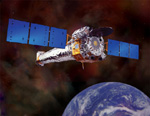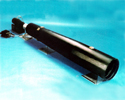An overview of the Chandra mission and goals, Chandra's namesake, top 10 facts.
Classroom activities, printable materials, interactive games & more.
Overview of X-ray Astronomy and X-ray sources: black holes to galaxy clusters.
All Chandra images released to the public listed by date & by category
Current Chandra press releases, status reports, interviews & biographies.
A collection of multimedia, illustrations & animations, a glossary, FAQ & more.
A collection of illustrations, animations and video.
Chandra discoveries in an audio/video format.
Disclaimer: This material is being kept online for historical purposes. Though accurate at the time of publication, it is no longer being updated. The page may contain broken links or outdated information, and parts may not function in current web browsers. Visit chandra.si.edu for current information.
The Director's Cut: On Orbit with Chandra
February 1, 2005 ::
The director of the Chandra X-ray Center, Harvey Tananbaum, recently sat
down with the Chandra Chronicles, where the discussion ranged from "nuts
and bolts" topics about the mission to big mysteries of X-ray astronomy.
In this installment, questions about the orbit and
spacecraft are explored.
Chandra Chronicles (CC): Does Chandra need constant power to orbit Earth?
Harvey Tananbaum (HT): Chandra does need power to operate in orbit - to
power its instruments, to control its pointing direction, to stay warm,
to communicate with Earth, etc. The amount of power it needs depends on
what it is doing, but is usually a little less than 1000 Watts - about
the same as a hair dryer so not very much at all to run an entire
satellite.
The amount of power can vary, but that is not really a problem since the
solar arrays on Chandra convert light from the Sun to electrical power
and provide just over 2000 Watts or about twice as much as Chandra
really needs. (Chandra does not use power to orbit the Earth - that
energy is provided by the force of the Earth's gravity and the energy
expended by the rockets which placed Chandra in orbit).
CC: Are there ever problems of not having enough power when Chandra
crosses behind Earth's shadow?
HT: Chandra does, in fact, pass through the Earth's shadow (effectively
blocking the Sun) for an hour or two several times over a period of a
few weeks every six months. We have three batteries on board Chandra and
these are fully charged when we are in daylight, so that they can
provide all of the needed power when Chandra is in the Earth's shadow.
CC: How often do the
data collected by Chandra get transferred back to
Earth?
HT: Chandra's on-board memory can store 16 hours worth of information
and we have two of these so technically we could go up to 32 hours until
we download the data. We get the data when we send the command from the
ground up to Chandra telling it to transmit the stored-up data. We do
this more or less every 8 hours to make sure that Chandra is still
healthy and safe and to stay far away from the point of filling up the
on-board memory. Once we download the data, we can re-use that memory space.
To communicate with Chandra, we use the Deep Space Network (DSN) with
its large radio dishes. There are three DSN
stations spread around the world - one in California, one in Spain, and
one in Australia. At any given time, at least one of these locations can
line up Chandra so we can communicate with the spacecraft. We just have to
share the DSN stations with other missions like the Mars Rovers and Cassini.
CC: I've heard the term "safe mode" or "safing" when it comes to
spacecraft in some sort of trouble. Can you explain more what that means?
HT: There are 2 kinds of safings for Chandra.
a. When radiation levels from the Sun get very high (during solar storms
or flares), the energetic particles could damage Chandra's CCD (Charge
Coupled Device) detectors if they stay at the focus of Chandra's
mirrors. So when we see a solar storm using special detectors on Chandra
or on other NASA satellites, we can tell Chandra to move the CCDs away
from the telescope focus to a "safe" hiding place, which is shielded.
This can be done automatically with software on-board Chandra or by
sending commands from our Control Center on the ground here in Cambridge,
Massachusetts.
b. If a major part of the Chandra spacecraft fails or malfunctions -
gyroscopes, reaction wheels, computer, etc. then Chandra is programmed to
automatically go into a safe hold. Chandra makes sure that it gets
enough energy from the Sun hitting its solar arrays, switches to back-up
systems, and waits for further action from the ground to diagnose what
has gone wrong and what should be done to restore Chandra to normal
operations. We have encountered this type of safing 3 or 4 times in the
5 years in orbit, but luckily all were simple errors here at the Control
Center rather than real hardware failures on-board Chandra.
CC: What does the Aspect Camera aboard Chandra do?
HT: The Aspect Camera on Chandra takes digital pictures of the sky in
"ordinary" or visible light. The stars in the picture are matched to
stars in catalogs taken with larger telescopes on the ground (and in
space) and stored as catalogs of stars. Matching the pattern of stars
tells us where Chandra is looking on the sky, and helps us to navigate
from one part of the sky to another.
CC: What do "pointing stability" and "pointing accuracy" mean, and how
do they apply to Chandra?
HT: Pointing stability is a measure of how well Chandra stays locked
onto a direction on the sky. This requirement is not nearly as rigorous
for Chandra as for the Hubble Space Telescope. We need to keep the
target source located near the center of the telescope to be sure that
its X-rays will be focused onto the detector at the other end and we
will see the target. Pointing accuracy is a measure of how precisely we
know where we have been pointing. For Chandra this is much more
important and much more demanding than the pointing stability -- at
least 10 times tougher.
CC: Chandra has already surpassed its original planned mission of five
years, but how long do you expect it will last?
HT: It is now nearly 5 1/2 years since Chandra was launched so we did in
fact meet the five-year minimum lifetime. We are hopeful that Chandra
will live at least 15 years. It has plenty of fuel and power to last
quite a bit longer than that, and it should stay in orbit for 50 or even
100 years. But things can go wrong. For example, eventually some
electrical parts are likely to fail. Over time the insulating blanket on
the outside of Chandra is becoming less effective at regulating heat
flowing in and out of Chandra so parts are getting hotter or colder than
we would like. Plus particles from the Sun are also causing a bit of
damage to our star trackers and to our CCD detectors. All of this causes
Chandra to age and at some point, perhaps 10 or more years from now, some
failure or other may make it impossible to operate Chandra - to point
it, to power it, to accumulate science data, etc. It is also possible
that an accumulation of these aging effects will dilute Chandra's
scientific capabilities to the point where it might not be worth
operating any longer. But, I hope that is not for a long, long time to come.
More facts about Chandra
Disclaimer: This material is being kept online for historical purposes. Though accurate at the time of publication, it is no longer being updated. The page may contain broken links or outdated information, and parts may not function in current web browsers. Visit chandra.si.edu for current information.










